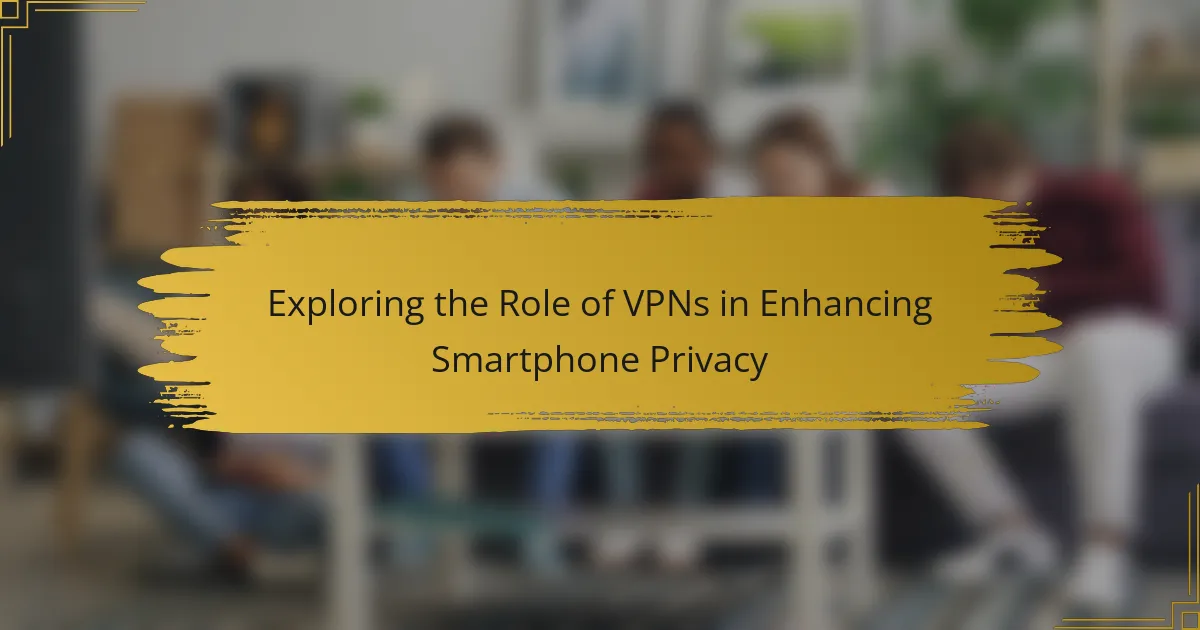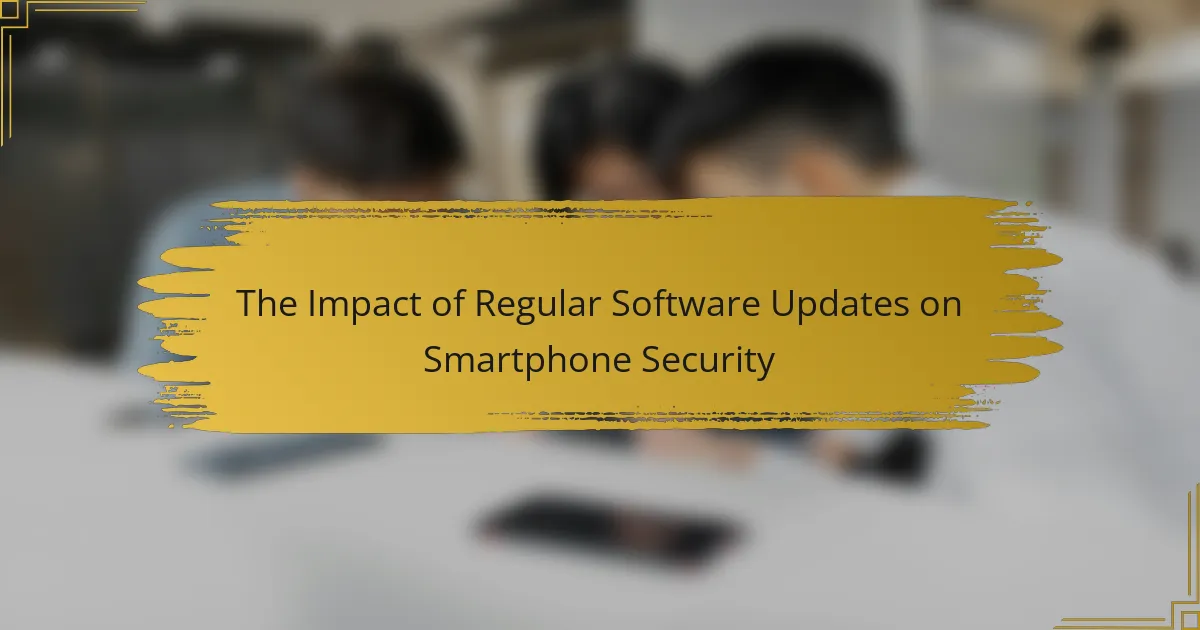End-to-End Encryption (E2EE) is a data transmission method that ensures messages are accessible only to the communicating users, with encryption occurring on the sender’s device and decryption on the recipient’s device. This security measure prevents service providers and third parties from accessing the content, significantly enhancing privacy in digital communications. E2EE employs complex algorithms and cryptographic keys known solely to the sender and recipient, thus safeguarding sensitive information from cyber threats. Key practices for maintaining security include using strong passwords, enabling two-factor authentication, and being cautious with public Wi-Fi networks. Understanding the encryption policies of messaging apps is essential for ensuring user confidentiality and protection against data breaches.
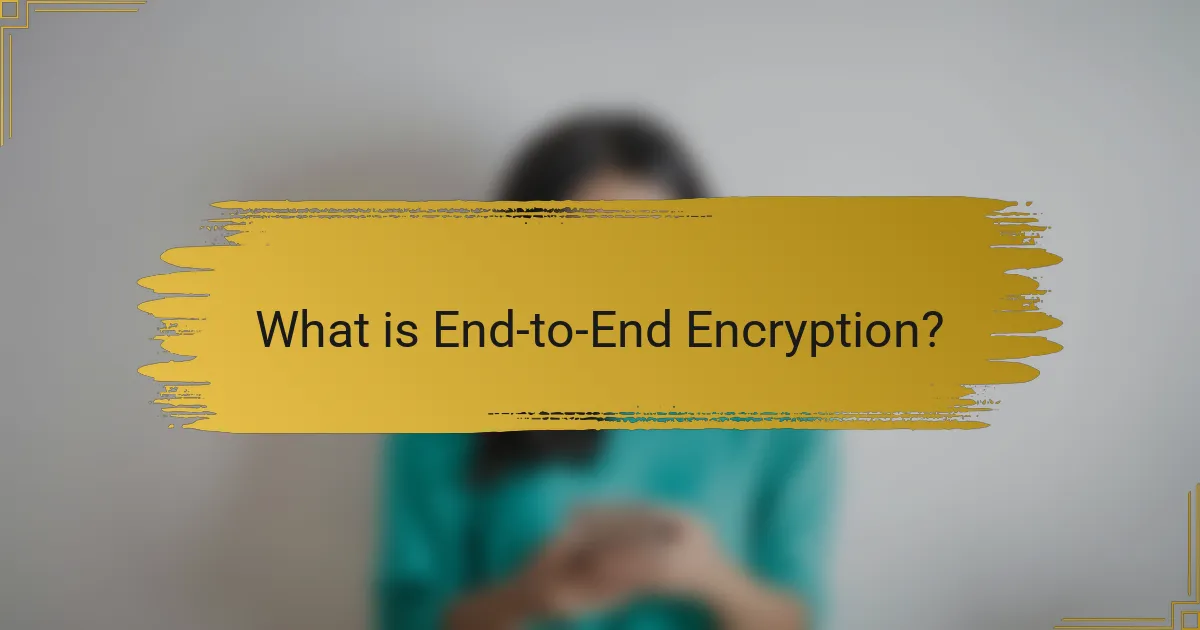
What is End-to-End Encryption?
End-to-End Encryption (E2EE) is a method of data transmission that ensures only the communicating users can read the messages. In E2EE, the data is encrypted on the sender’s device and only decrypted on the recipient’s device. This means that even service providers cannot access the content of the messages. E2EE uses cryptographic keys that are only known to the sender and recipient. The process protects messages from interception during transmission. According to a report by the Electronic Frontier Foundation, E2EE is crucial for privacy and security in digital communications.
How does End-to-End Encryption work in messaging apps?
End-to-End Encryption (E2EE) in messaging apps ensures that only the communicating users can read the messages. When a message is sent, it is encrypted on the sender’s device. This encryption turns the message into a code that is unreadable to anyone who intercepts it. The encrypted message travels over the internet to the recipient’s device. Once the message arrives, it is decrypted using a unique key stored only on the recipient’s device. This process means that even the messaging app provider cannot access the content of the messages. E2EE uses strong cryptographic algorithms to secure the messages, making unauthorized access extremely difficult. This technology protects user privacy and data integrity in digital communications.
What are the key components of End-to-End Encryption?
The key components of End-to-End Encryption (E2EE) include encryption algorithms, key management, and secure communication channels. Encryption algorithms convert plaintext messages into ciphertext, ensuring that only authorized parties can read them. Common algorithms include AES and RSA, which provide strong security. Key management involves generating, distributing, and storing encryption keys securely. Proper key management ensures that only intended recipients can decrypt the messages. Secure communication channels, such as TLS, protect data in transit from interception. These components work together to provide confidentiality and integrity for messages exchanged between users.
How do encryption keys function in this process?
Encryption keys are crucial for securing data in end-to-end encryption. They function as unique codes that lock and unlock information. When a message is sent, it is encrypted using the sender’s public key. This key transforms the message into an unreadable format. Only the recipient’s private key can decrypt this message. The private key is kept secret and never shared. This ensures that only the intended recipient can read the message. The use of asymmetric encryption enhances security. It prevents unauthorized access during transmission.
Why is End-to-End Encryption important for privacy?
End-to-End Encryption is crucial for privacy because it ensures that only the communicating users can read the messages. This encryption method secures data from the sender to the recipient, preventing unauthorized access. Even service providers cannot decrypt the messages, as they do not possess the keys. According to a study by the Electronic Frontier Foundation, such encryption protects against eavesdropping by hackers and government surveillance. In a digital environment where data breaches are common, End-to-End Encryption provides essential security for personal conversations. This protection fosters trust among users, knowing their private information remains confidential.
How does it protect user data from unauthorized access?
End-to-end encryption protects user data from unauthorized access by ensuring that only the communicating users can read the messages. The encryption process transforms the message into a secure format that is unreadable to anyone else. Only the sender and recipient possess the unique keys required to decrypt the message. This means that even if the data is intercepted during transmission, it remains inaccessible without the decryption keys. Moreover, end-to-end encryption is designed to prevent third parties, including service providers, from accessing the content of the messages. This level of security is supported by cryptographic protocols, which have been widely studied and validated in the field of cybersecurity.
What are the implications of not using End-to-End Encryption?
Not using end-to-end encryption can lead to significant security vulnerabilities. Without this encryption, messages can be intercepted during transmission. This allows unauthorized parties to access sensitive information. For instance, data breaches can occur, exposing personal details to hackers. Additionally, communication can be monitored by third parties, including governments and ISPs. This can result in a loss of privacy for users. Furthermore, without encryption, users may face identity theft risks. Overall, the absence of end-to-end encryption compromises the confidentiality and integrity of communications.
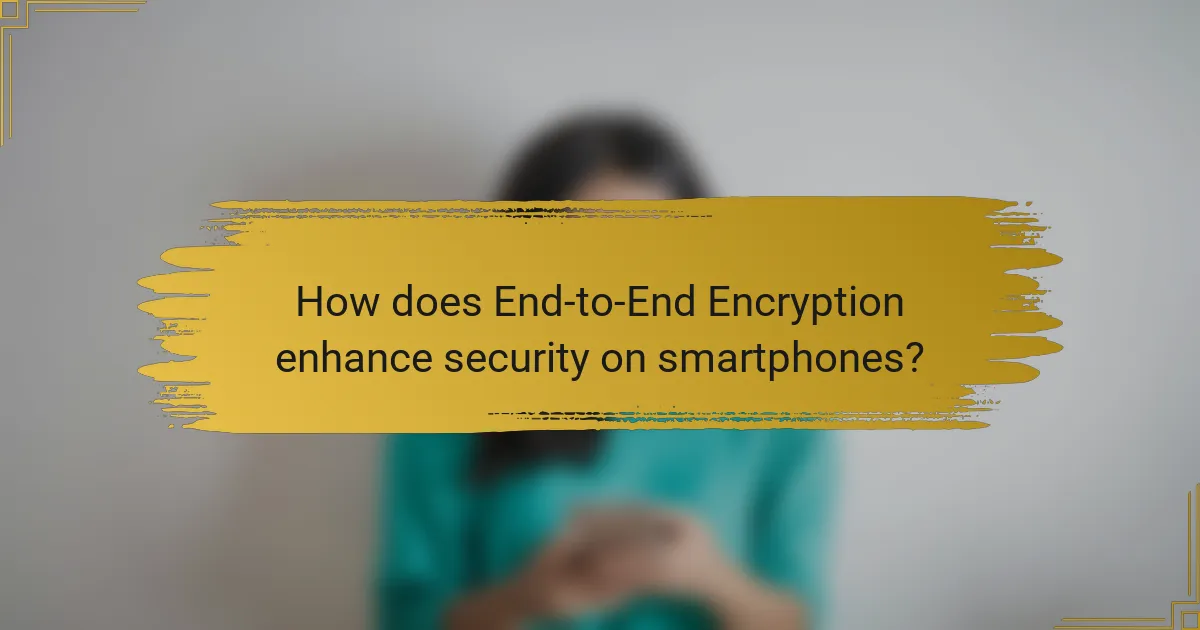
How does End-to-End Encryption enhance security on smartphones?
End-to-End Encryption (E2EE) enhances security on smartphones by ensuring that only the communicating users can read the messages. In E2EE, messages are encrypted on the sender’s device and decrypted only on the recipient’s device. This means that even if data is intercepted during transmission, it remains unreadable to third parties.
E2EE uses complex algorithms to secure the data, making unauthorized access extremely difficult. For example, popular messaging apps like WhatsApp and Signal implement E2EE to protect user privacy. According to a 2021 report by the Electronic Frontier Foundation, E2EE is crucial in safeguarding sensitive information from cyber threats.
By preventing unauthorized access, E2EE significantly reduces the risk of data breaches and ensures user confidentiality.
What are the common threats to message security on smartphones?
Common threats to message security on smartphones include malware, phishing attacks, and unsecured Wi-Fi networks. Malware can intercept messages and access sensitive information. Phishing attacks trick users into revealing personal data through deceptive messages. Unsecured Wi-Fi networks expose messages to interception by malicious actors. Additionally, device theft can lead to unauthorized access to messages. Outdated software can leave vulnerabilities that hackers exploit. These threats highlight the importance of securing messages with encryption.
How does End-to-End Encryption mitigate these threats?
End-to-End Encryption (E2EE) mitigates threats by ensuring that only the communicating users can read the messages. E2EE encrypts messages on the sender’s device and only decrypts them on the recipient’s device. This means that even if the data is intercepted during transmission, it remains unreadable to unauthorized parties.
E2EE protects against eavesdropping by third parties, including hackers and government surveillance. The encryption keys are stored only on the users’ devices, not on servers, reducing the risk of data breaches. As a result, even service providers cannot access the content of the messages.
Research shows that E2EE significantly decreases the likelihood of data theft. A study by the Electronic Frontier Foundation highlights that E2EE is a critical tool in safeguarding user privacy.
What role do smartphone operating systems play in encryption?
Smartphone operating systems are crucial for implementing encryption protocols. They provide the necessary frameworks and APIs for developers to integrate encryption into applications. These systems manage the encryption keys securely, ensuring that only authorized users can access sensitive data. Operating systems like iOS and Android have built-in encryption features that protect user data at rest and in transit. For instance, iOS uses hardware-based encryption, which enhances security by isolating encryption keys from the main operating system. Android offers full-disk encryption and file-based encryption options for user data protection. Both systems regularly update their encryption methods to address vulnerabilities and enhance security. The role of smartphone operating systems in encryption is fundamental for safeguarding user privacy and data integrity.
What are the limitations of End-to-End Encryption?
End-to-End Encryption (E2EE) has several limitations. It does not protect against endpoint security breaches. If a device is compromised, attackers can access unencrypted data. E2EE also does not prevent metadata collection. Metadata can reveal information about who communicated and when. Additionally, E2EE relies on strong key management practices. Poor key management can lead to vulnerabilities. Another limitation is that law enforcement may struggle to access data during investigations. This can hinder legal proceedings. Finally, E2EE can create challenges for user support. Service providers may not assist users with encrypted content.
Are there scenarios where End-to-End Encryption may fail?
End-to-End Encryption may fail in certain scenarios. For instance, if a user’s device is compromised by malware, an attacker can access unencrypted messages. Additionally, if the encryption keys are stored insecurely, they can be extracted by unauthorized parties. Another scenario involves the interception of messages before they are encrypted or after they are decrypted. If a user shares their encryption keys or passwords, it compromises the security of the encryption. Furthermore, encryption can fail if the software implementing it has vulnerabilities or bugs. According to a report by the Electronic Frontier Foundation, flaws in software can lead to decryption by attackers. These scenarios highlight that while End-to-End Encryption provides strong security, it is not infallible.
How do legal regulations impact End-to-End Encryption?
Legal regulations significantly impact End-to-End Encryption (E2EE) by imposing requirements that can affect its implementation. Governments may mandate backdoors for law enforcement access, undermining the security E2EE provides. For example, the UK’s Investigatory Powers Act requires communication service providers to assist in decrypting messages when requested. This can lead to vulnerabilities, as backdoors can be exploited by malicious actors. Additionally, regulations may vary by country, creating a complex landscape for developers. Compliance with such laws can force companies to choose between user privacy and legal obligations. Ultimately, legal regulations shape the balance between security and accessibility in E2EE systems.
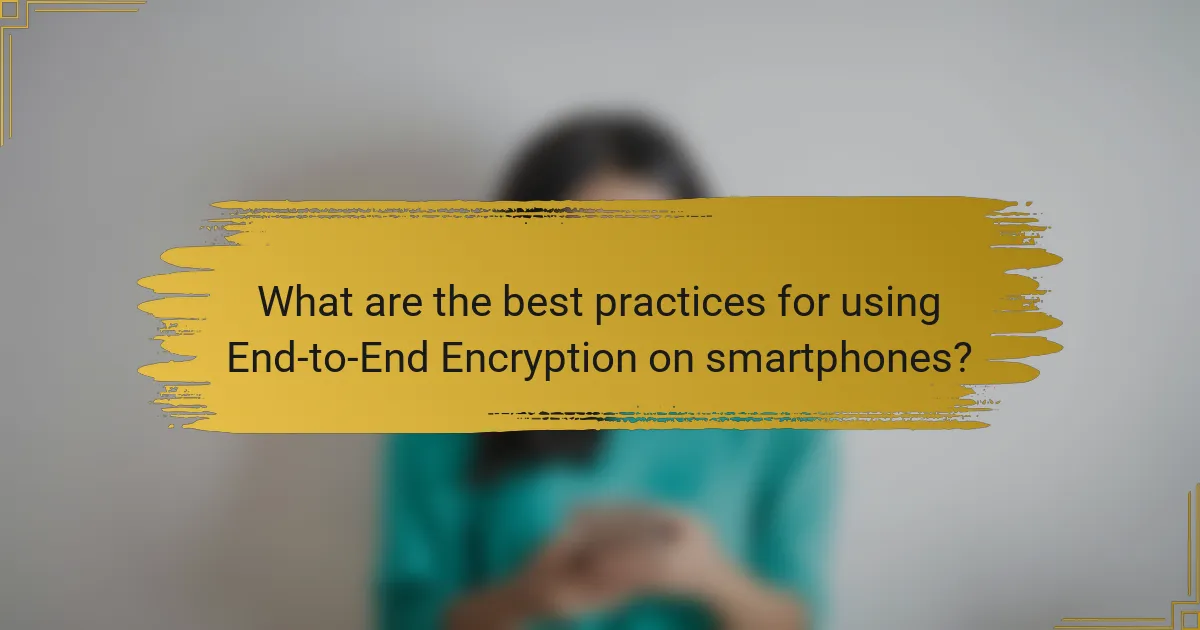
What are the best practices for using End-to-End Encryption on smartphones?
Use strong, unique passwords for your messaging apps. This prevents unauthorized access to your encrypted messages. Enable two-factor authentication where available. This adds an extra layer of security to your accounts. Regularly update your apps to ensure you have the latest security features. This helps protect against vulnerabilities. Be cautious when connecting to public Wi-Fi networks. Public networks can expose your data to interception. Always verify the identity of the person you are communicating with. This ensures that you are not communicating with an imposter. Finally, understand the encryption policies of the apps you use. Knowing how your data is protected is crucial for your privacy.
How can users ensure their messages are securely encrypted?
Users can ensure their messages are securely encrypted by utilizing end-to-end encryption (E2EE) applications. E2EE encrypts messages on the sender’s device and only decrypts them on the recipient’s device. This means that no third party can access the content of the messages during transmission. Popular messaging apps like Signal and WhatsApp employ E2EE protocols to protect user communications. Users should verify that the app they choose explicitly states it uses E2EE. Additionally, enabling two-factor authentication adds another layer of security. Regularly updating the app ensures that users benefit from the latest security patches.
What settings should be enabled for optimal security?
Enable two-factor authentication for added account security. This requires a second verification method beyond just a password. Activate biometric authentication, such as fingerprint or [censured] recognition. This provides an extra layer of security against unauthorized access. Ensure end-to-end encryption is enabled for messaging apps. This protects messages from being intercepted during transmission. Regularly update your device’s operating system and apps. Updates often include security patches that protect against vulnerabilities. Use a strong, unique password for each account. This reduces the risk of unauthorized access through password breaches. Finally, disable unnecessary app permissions to limit data access. This minimizes exposure to potential security threats.
How can users verify the encryption status of their messages?
Users can verify the encryption status of their messages by checking the app’s security settings. Most messaging apps display a lock icon or a security indicator next to encrypted messages. Users can also review the app’s privacy policy for details on encryption practices. Additionally, some apps provide an option to view the encryption status in the chat settings. For example, WhatsApp shows a message that states “Messages you send to this chat and calls are end-to-end encrypted.” This confirmation ensures that only the sender and recipient can read the messages.
What are some common troubleshooting tips for End-to-End Encryption?
Ensure both parties are using the same application that supports end-to-end encryption. Check if the encryption settings are enabled in the app. Verify that both users have the latest version of the application. Restart the application to resolve temporary glitches. Check internet connectivity, as poor connections can disrupt encrypted message delivery. Review device settings to ensure no restrictions are blocking the app. Clear the app cache to remove any corrupted data. Consult the app’s official support resources for specific troubleshooting guides.
End-to-End Encryption (E2EE) is a data transmission method that ensures only the communicating users can read messages, enhancing privacy and security in digital communications. This article explores how E2EE works in messaging apps, its key components, and the importance of encryption keys in safeguarding user data. It also discusses the implications of not using E2EE, common threats to message security on smartphones, and best practices for ensuring secure communication. Additionally, the article addresses the limitations of E2EE and how legal regulations impact its implementation, providing a comprehensive overview of E2EE’s role in protecting user messages.

